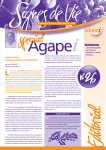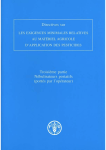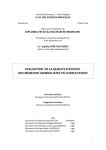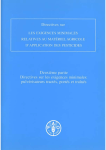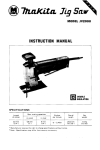Download THE ALTO USER`S PRIMER
Transcript
· I nls document IS tor XI:.HUX mternal use only THE ALTO USER'S PRIMER BY FRANK LUDOLPH JUNE 1978 XEROX WHOLE ALTO WORLD This document is for XEROX internal use only THE ALTO USER'S PRIMER INTRODUCTION I. THE NETWORK Alto Ethernet Transmitting data Receiving data Gateway Servers Printers File Storage Electronic Mail Boot Files Time Device Name List Network diagram II. THE FILING SYSTEM Alto Filing System/Filenames File Servers III. WHAT YOU NEED Documents Overview Basic Document List Subsystems Accounts Keeping Up- To- Date IV. OPERATIONAL PROCEDURES Operating the Alto .. On/Off Loading/Unloading a disk Booting Checking· Out Your Machine Workstation Disk Drive Alto Processor Using the Executive Starting a service Correcting typing errors Aborting a service InitializinglInstalling a New Disk Copying Using the network Installing a new disk Retrieving basic set of files a: Normal Disk Maintenance Listing filenames Listing file attributes Display a file's content Deleting files Grouping files Disk Crash! The User Command file Printing Press files Bravo files Ears files Gypsy files Text files TTY files Other printers 1 TIlE ALTO USER'S PRIMER INTRODUCTION Most of the existing documentation for the Alto and its systems tell you how to use the Alto, Bravo, FTP, etc. The purpose of this paper is to present what exists and where to get it. It is intended as a first reading for the new user and is primarily non- technical in its presentation. The first chapter, THE NETWORK, presents a brief overview of the system's services, components, and their interconnection. The second describes the filing systems, both Alto and IVY, and their interaction. The chapter, WHAT YOU NEED, presents an overview of the documentation available, lists the minimal set of documents and subsystems needed to get started and where to get them, and tells you how to keep up- to- date. Lastly, there is a how to chapter comprised of operational procedures that either have been revised or are unrecorded elsewhere. Many of the sections reference documents for further study. While many of them should be available from your local file server, the orginal source is indicated. It is advised that these papers not be read until reading of the Primer is completed and fully understood. Many sites have established local procedures to cover establishing accounts and methods of obtaining and initializing disks. Ask other machine users in your group or area to direct you to the appropriate people. In case you find yourself all alone or no one seems able to help you, call the Whole Alto W orId coordinator. Currently the coordinator is Frank Ludolph. You can reach him at Intelnet number 8*923-4356 or sending by a message to <Ludolph>. A word on protecting Xerox information. The systems you are using are prototypes for future Xerox products. Much of the technology involved cannot be covered by patent; your discretion is required in protecting these developing technologies from premature disclosure. While the corporation has publicly indicated its intention to market a broad range of Office Information Systems products, it has been mute on exactly what form they might take. Telling your friends about the systems you use may damage Xerox's profitability based on these technologies by either prematurly indicating trends in future products or preventing the patenting of a process. Don't chance diminishing the success of future products by your indescretion. After reading the Primer, it is suggested that you aquire the basic set of documentation and accounts, find an Alto, and get some hands- on experience. The OPERATIONAL PROCEDURES section in this paper and the Alto User's Handbook can be used to build yourself a disk. Then tryout FTP, the file transfer program, and Bravo, the text editor. Next use a couple of the graphics programs, Draw, Markup, and Sil. Create some documents and print them; these are all functions that you will probably use no matter what else you do. Now that you're fairly conversant with the Alto, look through the Subsystems Catalog for other subsystems that you might want to use, retrieve the documentation and programs arid try them out. You're off and running. Enjoy. 2 mE ALTO USER'S PRIMER I. THE NETWORK The. network is composed of Altos and other computers connected to several geographically dispersed, technologically innovative local computing nets which, in turn, are tied together by minicomputers over standard leased and/or dial-up telephone lines. The local computing nets are called Ethernets; the mini- computers linking them are referred to as Gateways, the latter providing several services in addition to linking together Ethernets. The last page of this chapter is a diagram of the network as it is currently implemented. THE ALTO The Alto is used to prepare and print documents containing text, diagrams, and images, to convey messages electronically, to aid circuit and IC design, and, to write programs. It is a minicomputer consisting of a processor, disk drive, workstation, and Ethernet transceiver. Optionally, it may be ordered with a Diablo HyType printer and/or a second disk drive. The Alto can also be used to drive other devices ranging from communications interfaces to production machines. (See the Alto Hardware Catalog for a comprehensive listing.) The microcoded processor has 64K of 850ns, 16- bit word semiconductor memory (extended memory versions are available). A 1K microinstruction RAM can be loaded with special purpose microcode to extend the instruction set, perform special functions or drive special I/O devices. It is packaged with the disk drive and power supplies in an under- table- size cabinet for easy placement in the user's office. The disk drive commonly supplied with the processor is the Diablo Model 31 disk drive, though other Diablo models can be used. The Model 31 accepts a single disk which can be used to store about 2.5 megabytes. The average seek time is 70 ms, the average transfer rate, 1.22 MHz. A second drive can be added. This disk can either be treated as an extension of the first (the two disks are paired when the filing system is initialized) or as a local file server used to store files when not required for processing. In the latter case, only certain programs on the main drive can access files on the second drive. The workstation is composed of a vertically oriented video display which is refreshed 30 times per second, a standard keyboard with a few extra blank function keys, a mouse (pointing device), and five- finger chordset. The display is composed of 808 lines, each line having 606 individual points (a 606 by 808 bitmap). Each point can be individually controlled to produce not only text but also graphics and even pictures. The cursor, whose position is controlled by the mouse, is a 16x16 bitmap whose shape is under program control, independent of display content. The workstation may be augmented with a Diablo HyType printer. This is a typewriter-like device with proportional spacing used to create hardcopy output. The Ethernet transceiver connects the Alto to the Ethernet, described below. Using the Ethernet, the Alto can communicate with a large number of other Altos, computers, and special purpose servers. mE ALTO USER'S PRIMER 3 See: Alto User's Handbook and [MAXC] (AltoDocs)Subsystems.press, Executive section (operation); [MAXC] (AltoDocs)AltoHardware.press (hardware description) and [MAXC] (AltoDocs) HardwareCatalog.press (peripherals description). THE ETHERNET The Ethernet was designed to provide a highly reliable communication facility for computers located within a single building or small complex. It consists of a single length of coaxial cable (the Ethernet) and transceivers that connect each computer to the cable. Each computer on the Ethernet has a unique three digit octal address and the Ethernet itself has a unique two digit octal address. The Ethernet addiess is wifed on the Ethernet board in the Alto. Data sent over the Ethernet is sent in packets, each packet containing the net and machine addresses that identify the source and destination machines. TRANSMITTING DATA Rather than controlling access to the cable by a single active element whose failure would result in the loss of the communication channel, control is distributed among the transceivers and communicating programs. Each transceiver, specially designed to prevent contamination of the Ethernet in the event of failure, verifies that the cable is clear before transmitting and listens during transmission for interference, retransmitting at a randomly determined later time if interference is detected. Each packet of data transmitted is assumed to have only a high probability (as opposed to certainty) of reception; it is the communicating programs' responsibility to verify receipt of data and retransmit if necesary. RECEIVING DATA The interface module checks each packet as it passes for its own net and machine addresses. Packets with matching addresses are buffered and passed to the executing program. The program will normally acknowledge receipt of the packet by transmitting to the sender an appropriate reply. The receiving program should be prepared to discard duplicate packets (the sender may not have received the acknowledgement and retransmited the packet, assuming it was lost). See: Ethernet: Distributed Packet Switching for Local Computer Networks by Robert Metcalf and David Boggs. Parc Universal Packets (PUP) are described in several papers on [MAXC] <PUP), especially PUP.ears. THE GATEWAY The Gateway's primary function is to transmit packets between Ethernets. It is a small computer (currently Novas but soon to include Altos) that attaches to an Ethernet in a manner similar to any other computer except that it responds to all packets addressed to other nets. Each off- net packet is picked up, encapsulated, and routed over the appropriate lines to other Gateways. Transmission of data packets through Gateways is transparent to the sending and receiving programs; packets, after passing through Gateways to the destination Ethernet, are identical to the original packet; 4 THE ALTO USER'S PRIMER More than one Gateway may be attached to an Ethernet and there may exist more than one path between two Ethernets, that is, there may be loops forming a true network structure. (Remember that it is the responsibility of the communicating programs to recognize and discard duplicate packets.) The Gateway also provides bootfile, time, and name look- up services. These functions are described below. See: [MAXC] <PUP> for some papers on Gateway protocols. SERVERS Servers provide services that can be provided more effectively in a centralized fashion. In general these services require special hardware, use intermediate facilities to provide aroundthe- clock access, extend local facilities (file storage), or provide backup. PRINTERS A printing server consists of an Alto, a printer, and usually some additional disk storage (a second Diablo 31 or a Trident T- 80). Like all other Altos on the network it has an address and usually a name (see the Ethernet Description above). To send a file to a printer, the printer's name or address must be indicated. To save you the extra keystrokes of entering the printer's name or address every time, a default printer can be specified in the [HARDCOPY] section of the User.cm file. (See the PRINTING and USER COMMAND FILES sections under OPERATIONAL PROCEDURES). Once the User.cm file has been modified, you need to specify a printer's name or address only when you wish to use a different printer. The most common printers are Spruce printers (Spruce is the name of the software that runs on the printer's Alto). They will print Press format files containing text and graphics, e.g. line drawings, of limited complexity. (For directions on how to send a file to a Spruce printer see PRINTING). The server listens to the Ethernet, waiting for a print request. When a request is detected, the file to be printed is transferred as soon as possible to the printer's disk (but not until the printer has finished printing the current file). These spooled files are then converted, in the order received, to a format suitable for printing and printed. Spruce is normally run on two types of printers: Dover and Sequoia. Dover is a high volume printer, its output looking very much like a good clean xerographic copy. Sequoia has better solid area development, that is, the blacks are blacker, but is intended for low volume (not over 200 sheets at a time). Dovers are gen'erally available 24 hours a day, Sequoias only during normal working hours (due to limited component life). Your User.cm should probably specify a Dover, if possible, as your default printer. Press printers, i.e. printers running Press software, will print not only text and graphics of unlimited complexity, they will also print images such as halftoned photographs. Press is rather more complex to use and generally does not run in server mode; you must personally 5 THE ALTO USER'S PRIMER supervise the transfer of the print file and initiate printing (although a form of server mode can be setup when appropriate). Press can be run on any of the printer hardware but is normally run only for experimental purposes on printers other than Dover and Sequoia. (Images cannot be printed on Dover by Press because of the Dover's high speed). See: [MAXC] <GR· Docs> Printing.press, Subsystems Manual, [ IVY] <Spruce> S pruceManual.press, and [MAXC] <GR· Docs> PressOps.press. Empress section, FILE STORAGE The Diablo 31 disk drive that comes with the Alto can store about 2.5 million bytes on a disk. That sounds like a lot but after putting on an operating system and various subsystems, it starts to dwindle rapidly. One solution is to have a lot of disks, but changing disks takes a couple of minutes and sometimes you need· a file off another disk. Transferring files between disks can be inconvenient, particularly if you don't have a dualdisk Alto. It can also be kind of scary if you have only one electronic copy of a file; in the admittedly unlikely event of a disk failure, you may have to completely re- enter or recreate the file, if you can. The solution to these and other problems is a file server, IVY (or IFS), usually one per geographical site. An IVY station consists of an Alto and one to eight Trident T- 80 and/or T- 300 disk drives, each unit having 80 and 300 megabytes of storage respectively. An IVY account, obtained from the local IVY adminstrator, will provide you with an additional storage as needed. With your own account, you will have access to public subsystems and documentation maintained on special directories; and you can freely move files between the Alto disk and your IVY directory. Keep files on IVY that you have finished with but wish to keep around for future use. Use IVY as it seems convenient. Don't worry about deleting a file from your disk after transfering it to IVY. Not only is there a excellant program to rebuild Trident disks in the event of a failure, but, at most sites, files are also backed up each night on a second disk for use in the event of a catastrophic failure. Files on IVY aren't quite as private as on your Alto disk; though others can't write over them unless explicitly given permission, they can read them unless you invoke IVY's protection facilities to prevent it. In any case, others can still list the filenames, protected or not. There is a second file server on MAXC, a large computer OIl the Ethernet located at PARCo It is used in a manner similar to IVY but is intended for use by PARC people and others that work closely with them, such as SDD and ASD. MAXC also provides storage facilities for the mail servers discussed below. See: [MAXC] <IFS> HowToUse.press(user manual) and Operation.press (administrator manual). ELECTRONIC MAIL has replaced the short hand-written memo for Alto users. Messages handled in this manner are delivered immediately to as many people as appropriate, provided of course that they have a MAXC message account. Message accounts are generally available to members of PARC, SDD, ASD, and others that work closely with PARCo Attempts are being made to establish at least one group account for each Alto- using group '!HE ALTO USER'S PRIMER 6 in order to give all users access to the message system. There are two message systems now in use: MSG, which is run from your Alto on MAXC, and Laurel, which runs entirely on the Alto, using MAXC only to hold undelivered mail. MSG is a teletype oriented system with comparatively primitive editing facilities, though it does provide a wide set of message control operations. All messages, both intransit and received, and the MSG software reside on MAXC. Laurel is now replacing MSG. The major differences are that it is oriented toward Alto- type operations, such as menu picking and Bravo- type editing, and resides entirely on the Alto disk. Undelivered messages are currently kept on the MAXC file server but they will scion be held on IVY. To receive messages from Laurel you must have a MAXC' MSG account, though it does permit people without message accounts to send messages to registered users. MSG and Laurel are essentially compatible; users of each can send messages to the other. See: [MAXC] < OMS) Laurel.press. BOOT FILES One of the secondary services provided by Gateways is the boot server. Several standard subsystems have been converted to boot file format. This permits them to be stored on the Gateway's disk and transmitted on request to your Alto. This saves you disk space and permits you to execute those programs even when you don't have a good disk available. Some of these boot files enable you to build a working disk, some are commonly used programs, and some are diagnostics used. to verify the operation of your machine. See: <AltoOocs)Subsystems.press, NetExec section. TIME Your Alto may try to set the time- of- day whenever it is booted. If possible it will get the time from another machine on the Ethernet. Since the Gateway runs 24 hours a day, a time server has been included in the software. Gateways will, in turn, attempt to get the time from other Gateways, so everyone should have the same time, adjusted for their own time. DEVICE NAME LIST Each device attached to the Ethernet has an address and, probably, a name. Names are provided because they are easier to remember and can be used to provide an indication of the machine's use. Since only addresses are recognized by the Ethernet interface, the address of a destination machine must be substituted for its name before sending a packet. The Gateways maintain a name/address correspondence file and provide a name lookup service so that programs on originating machines can request the address of the user- supplied machine name. 7 TIlE ALTO USER'S PRIMER XEROX ALTO NETWORK MAY, 1978 MAXC 32 LINES 1008 ARPA NET <y> r----. V' >-----1 IMP 1I J XTELNET MAXC II DLS ~I~ IPARC ~~~~==~~==~~~~~~~~~~~----~~~~2nd floor IVY DOVER DOVER PIMLICO ~LOT 31 EARS (109 Altos)!3# }JI MENLO 155# CLOVER 121 # VIOLA 341 # SLOT- 2 116# PALO 3# ~~__________________________________________~~;~Rf3rd ~),.---_(31""""" ( IVY 325# I (10 Altos)· 6 # '. DOVER WONDEF 265# ISDD/PA t;=:t=~;::::t::~-:::::!::::--:::::!:::;-:::::I:::;-------;:-=:1 Bldg 33 & 3.! G ceDI .[~ DOVER DOVER DAISY 6# SEQUOI (50 Altos)15 # KANJI 52# p-~____~__~________________ ··_·________~IXEOS ...... _ r-- ~ ~ IVY IRIS 50# (3 I I I (18 Altost12 # ~EQUOI'- IVY DOVER XEOS 130# WHITE 122# ARCTIC 200# IVY IFS-2 DOVER DOVER ROVER ._- ... __ .. . -- ~~____~____~____.-____~__-.____________-tISDD/ES l" _ ~ SEQUOI GIANT ~EQUOI ARDVAR (91 Altos)11 '. SEQUOI, COSTAL 0# (3 (3 ~=IV~y==~----------------------------------~(4~A~lt~os~)113# 4# 204# 15# @t--..,....._........ ADL 200# '------I _~ (3 I I IVY· WRC 113# SEQUOII SEQUOII 111 # 105# 13# IADL/ES 104# ________......IWRC I DOVER (24 Altos)114 # Filed on [MAXC] <AltoDocs) AltoNetwork.press TYPE AL TO Server NAME ~mDRES (AL~P + Device) O NOVA (G is wI pup Gateway software) -0 Other Resource 8 TIlE ALTO USER'S PRIMER II. THE FILING SYSTEM Files contain documentation, subsystems, or data and are stored on a disk, either the disk in the Alto or the disk of a file server. The subject of files is very important in the operation of the Alto so take the time to understand it completely. THE ALTO FILING SYSTEM The Alto stores on its disk all the material with Which you work, as well as the programs you use. Each document and each program is stored as a different file. Because the storage space on a disk is finite, programs and the materials they require may be grouped on different disks, for example a document disk, a BCPL programming disk, a MESA programming disk, and a Design Automation disk. A disk will normally function well if there are several hundred free pages. Let experience and the amount of free space on the disk be your guide. Some disk maintenance techniques are contained in the OPERATIONAL PROCEDURES chapter. A file is identified by its name, a string of letters, digits, and the characters "+ .!$" and is no more than 39 characters in length. Upper and lower case letters can be used interchangeably; they're identical to the filing system. No spaces are permitted. The filename can have two parts, the main name followed by the extension, separated by a period. The main name is any group of characters that make sense to the creator of the file. The extension is used in a systematic manner to give people hints as to what the file is for. For example, a program has the extension ".run". Files created by a program often have the program's name at its extension, e.g. Report.bravo was created by the program Bravo.run. In a few cases, the extension indicates the format or intended use of the file; Document.press is a file that can be printed. Common extensions are: .AL .BR .BOOT .CM .DM .EARS .EP .PRESS .RUN .SYMS .TTY Alto display fonts Precompiled modules ready for loading with others to form a program Subsystems files that can be executed directly off a boot server Command files which the Executive will treat as keyboard input Groups of files packaged together for easy transfer and storage Document files ready to print on the Ears printer (Palo Alto only) Ears fonts (Palo Alto only) Document files ready for printing on printing servers Subsystems (programs) Symbol tables used to debug a program Document files that can be printed on servers And don't forget all the extensions that reflect the creating subsystem e.g.. BRA VO, .BCPL, .MESA, and .DRAW. See: Alto User's Handbook. 9 TIlE ALTO USER'S PRIMER THE FILE SERVERS Files are also located on the IVY and MAXC file servers (see THE NETWORK). The storage space is broken into chunks, each with its own directory. Some of the directories contain files intended for general distribution, such as subsystems and their supporting documents, while others provide individual users with a place to store files when not required on the Alto disk. To get a chunk for yourself you need to get an account from your local IVY administrator. A file must be on the Alto disk to be used; the file servers are only for storage. Each of the file server stations has a name, just like all the other machines attached to the network. Many of them are named for the facility or group they serve, e.g. WRC, XEOS, and ADL. The network diagram at the end of the first chapter indicates all the stations. Names of files on servers are the same as on the Alto disk except that a server needs an additional part, the directory. If you want to tell someone else where to retrieve a file, they must also know the server's name. For example, the Executive subsystem is stored on [MAXC] (Alto> Executive.run. Notice that the name of the server is enclosed in "[ ...]" and the directory in "( ...>". When it comes time to retrieve the file, you will connect to the server and identify the file by the directory, main name, and extension. Note that the directory can also be of the form "( ...> ...>". The name between ") ...>" is a subdirectory name and is used to group files in a fashion similar to the extension. Using a file server you can: list the names of files under a directory,~ retrieve subsystem and document files from public directories, retrieve files from other directories if the files are unprotected (the default), store and retrieve files from your own directory, store files under other directories if you know the password for that directory. See: <AltoDocs)Subsystems.press, FTP section, and [MAXC] <IFS) HowToUse.press 10 mE ALTO USER'S PRIMER III. WHAT YOU NEED Much of what you will need, programs and their documentation, is stored on file servers. Typically programs and program modules are stored under the <Alto> directory. Documents are placed in the <AltoDocs> directory. There are some exceptions which will be pointed out below. A program, when retrieved onto the Alto disk is immediately usable, though some first must be installed (normally performed by typing program name/i). Documents may be viewed on the screen using Bravo if they have the extensions .bravo or .memo, using Markup if the extension is .press, or with Type, an Execu~ive routine, if in a .tty file. If you want printed documents, see the section on printing under OPERATIONAL PROCEDURES. DOCUMENTS One of the most difficult problems when learning to use a new system is finding the existing documentation. A hierarchy of documentation has been created with this document as the root. The overall documentation scheme is illustrated in the figure below. ALTO USER'S PRIMER .. PREPRINTED DOCUMENTS I i- LOCAL FOLKLORE DOCUMENTS _ CATALOGS i- ENGINEERING DRAWINGS W ,OLE ALTO WOR D NEWSLETTER SUBSYSTEMS I l HARDWARE MANUALS SUBSYSTEMS AND PACKAGES HARDW ARE DOCUMENTS i-- 1ri:>.IVIDUAL MANUA S Several commonly used documents have been printed and bound. These include the Alto User's Handbook, the Bravo Course Outline, and the MESA Language Alanual. The Handbook contains introductory material on how to get started on the Alto and manuals for several commonly used subsystems: Bravo, DDS, Draw, FTP, and Markup. Though it was written in late 1976 and is somewhat out of date, it is well done. It is certainly accurate enough for the beginner; most of the changes have been in the form of enhancements or additions. 11 'IHE ALTO USER'S PRIMER The Bravo Course Outline is a comprehensive teaching and reference guide to using Bravo, a widely used text editor. There is a companion workbook that contains practice material. Both have been recently updated. Local folklore covers a number of papers written to document local procedures and supplement program manuals for several subsystems. Though intended primarily for use at the site for which they were written, you will find them useful at other sites as well. Folklore documents known to exist are: . ORGANIZATION SDD PARC XEOS FILE(S) [ IRIS] < SDSUPPORT> SDDocs> * (several files) [ IFS- 2] < SbSUPPORT> SDDocs> * (same as on [IRIS]) [MAXC] < AltoDocs> ParcAltos.tty [XEOS] < AltoDocs> Folklore.bravo There are catalogs that list and briefly describe subsystems and hardware. Each entry also references the supporting documentation. In addition, the software catalog crossreferences the subsystems by function to simplify locating a program to perform a given task. They are stored under the < AltoDocs> directory on most servers as SubsystemsCatalog.press and HardwareCatalog.press. Most subsystems are documented in the Subsystems Manual, a compendium of individual manuals. Most of the smaller subsystems are included, only the larger documents are absent. Each of the included subsystem manuals is also available individually as a .tty format file. As new versions of subsystems are released, retrieve arid print the revised documentation and replace that part of the Subsystems Manual. A similar collection, the Packages Manual, contains documentation relating to general purpose program modules. Engineering drawings, EOs, for the Alto are forwarded to maintenance people by the coordinator as changes are made to the existing hardware. The Whole Alto World Newsletter is a monthly publication for Alto users. It contains information of a timely nature, notes on hardware and new and revised software, and papers on Alto- related technologies. Contact the coordinator if you wish to receive the Newsletter. BASIC DOCUMENT LIST Most of these documents can be obtained from the local file server (or MAXC) and printed on a Dover or Sequoia. Some of them are not available in electronic form. Those documents may be obtainable locally. If not, contact the coordinator, listed in the INTRODUCTION, for help. The following list is not comprehensive, but should be sufficient to begin with. DOCUMENT Alto User's Handbook Bravo Course Outline Subsystems Catalog Alto Subsystems How To Use IFS Laurel Reference Manual SOURCE Local sources Local Sources < AltoDocs> SubsystemsCatalog.press < AltoDocs> Subsystems.press <IFS> HowToUse.press [MAXC] < DMS> Laurel.press 12 THE ALTO USER'S PRIMER If you intend to do some BCPL programming you will need: BCPL Reference Manual Operating System Manual Alto Hardware Manual Packages Manual Gypsy Operator's Handbook < AltoDocs> BCPL.press < Alto Docs> OS.press < Alto Docs> Alto Hardware. press < AltoDocs> Packages.press < Al toDocs> Gypsy .press If you wish to use MESA and are outside SDD, PD., ASD, or PARC, contact the coordinator. Design Automation System users will need the SIL Manual on [IRIS] <SIL>SilManuaLpress. It includes documentation on the other programs in the system. SUBSYSTEMS When a new disk is built, what subsystems should be put on it? That, of course, depends on what it will be used for, but that normally breaks down into just a few categories: document creation, BCPL or MESA programming, or Design Automation. (Of course there are several specialized functions but if you know about that, this Primer probably isn't necessary.) Almost everyone needs a non- programmers disk (document creation), even if they intend to program, so we'll start there. The disk should contain: BASIC SYSTEM SUPPORT EXECUTIVE INST ALLSW AT run to put SWAT and SW ATEE on the disk USER.CM contains user settable defaults for many subsystems FILE MANAGEMENT moves files between Altos and a file server SCAVENGER restores a flaky disk (if space is tight, use the boot server) DDS simplifies disk maintenance PUT for disk maintenance, smaller than DDS but fewer functions FTP . or DOCUMENT CREATION BRA VO text editor SIL diagrams of vertical and horizontal lines with captions and/ or MARKUP diagrams that include diagonal lines and mouse tracks and/ or DRAW diagrams that include curves PRESSEDIT merges text and diagrams EMPRESS sends files to a printer (.press and .tty formats) NPPR converts .sil format files to .press for printing FONTS (files containing characters of different styles) TIMESROMAN*.AL several sizes of characters with serifs (like these) several sizes of characters without serifs (like these) HELVETICA *.AL MATHIO.AL math and logic symbols for BRAVO LOG024.AL letters X,E,R and 0 13 THE ALTO USER'S PRIMER HIPPOIO.AL GATES32.AL Greek alphabet e.g. apg8!lTp. ... arrows and things for use with SIL This is a minimum set but it will get you started. Most of these files can be obtained easily by retrieving and executing the NPDISK.cm command file. See the disk initialization procedure in the OPERATIONAL PROCEDURES chapter. Other command files exist to simplify the retrieval of other file groups. These are the most commonly used; the list is by no means complete. adds Bravo 7 (automatically retrieved by NPDISK.CM) BRAVO.CM MESADISK.CM makes an initialized disk into a: MESA programmer's disk makes im initialized disk into a BcpL programmer's disk PDISK.CM adds Design Automation programs to an initialized disk SIL.CM ACCOUNTS If your machine is a part of the network you will probably need to obtain IVY and message accounts. IVY is a file storage facility (server) usually located at sites having ten or more Altos. (IVY's old name is IFS.) Stored on IVY are documents, files, and subsystems (computer programs or services) that you will need later on. Contact the local IVY administrator. In case you can't get an account right now, most IVY servers have a guest account, GUEST, password: Guest, that can be used to retrieve files. This is especially useful - when retrieving files from other than the local IVYserver:If you are at PARC, you may need access to MAXC, a large computer that is part of the network. In general, MAXC accounts will not be issued to non- PARC people. The question of message accounts is somewhat up in the air at the moment due to the changeover to Laurel. Once Laurel is in general use, local administrators will handle the assignment of accounts. Until then, message users must have access to a MAXC account. PARC, SDD, and ASD people are regularly assigned accounts. Group accounts are issued so that other individuals may also use the message facilities. KEEPING UP· TO· DATE The Alto exists in a rapidly changing environment. It requires some effort on your part to keep up· to· date, but you do have help. Some of the software developers use the message system to announce new or rereleased subsystems and packages, usually with updated documentation; The Whole Alto World Newsletter gathers these announcements together, along with unannounced changes, on a monthly basis. (It also includes documentation on newly released software, information about the hardware, no~es on system operation, and papers on technologies affecting or affected by the Alto. If you would like to receive the Newsletter, contact the coordinator as indicated in the INTRODUCTION.) TIlE ALTO USER'S PRIMER 14 Once you know of revised documentation, retrieve and print it. Using the Subsystems and Packages Manuals as a base, replace the updated sections with the documents just printed. Many of the documents contain a revision history as the last section. Review the changes indicated there and in the Newsletter and you will find that you can remain up- to- date with just a couple of hours effort each month. 15 IV. OPERATIONAL PROCEDURES OPERATING THE ALTO The Alto itself is a very simple machine for people to operate. There are only three things you need to know: loading a disk, booting, and turning it on and off. (Of course there are additional procedures for controlling each of the subsystems.) ON/OFF The Alto was designed and is intended to be left on at all times. When the machine is off, all lights are dark. Look for a red POWER light on the front of the machine. Older Altos (Alto I) generally have the power switch on the back of the display base; reach around to the right. On newer. Altos (Alto II) the power switch is inside the processor cabinet (the big box on the floor). Using your thumbs, push in on the brushed alumninum plates (left and right front) and pull out a couple of inches. The switch is inside the top, left corner. Don't turn the machine off unless local procedures tell you to. When turning ON or OFF always verify the the disk is off, i.e. the RUN/LOAD switch is in the LOAD position and the yellow READY light (light, front) is out and the white LOAD light is on. LOADING/UNLOADING A DISK The Diablo Model 31 disk drive used with the Alto has a protection mechanism that prevents the disk access door from being opened when the disk is spinning or when the power is off. If you look carefully through the smoked plastic panel, you can see a little flag that says LOCK just to the left of the disk pack hand hold when the disk is on (spinning). Don't try to open the access door when this flag is up, something may break if forced. To load the disk, verify that the Alto is on, the LOAD/RUN switch (front, top, left) is in the LOAD position, and the white LOAD light is on. Open the access door by pulling out and down on the handle (cross bar at the top, front), and gently slide the disk in while holding the pack by the hand grip. Close the access door and push the LOAD/RUN switch to RUN. The white LOAD light will go out and, after about a minute, the yellow READY light will come on. The disk is now loaded. To unload a disk, push the LOAD/RUN switch to LOAD, wait about about a minute for the white LOAD light to come on, open the access door, and slide the disk out. Some of the doors get sticky, so if it doesn't open easily, verify that the LOAD light is on and try again. (If you want to make really sure that it isn't locked, look for the flag through the smoked panel; it should be down.) BOOTING The purpose of booting is to load into the Alto a copy of a program from an outside source. Normally, the Alto is booted from the disk (diskboot), so the first step is to load an initialized disk. If you have one, ready it. To boot using a disk, depress the boot button located on the back of the keyboard about an inch to the right of the thick, black cable. You should hear the disk rattle and a few seconds later, some text should appear at the top of the screen and a ")" about halfway down the left side. The boot operation is complete. The ") n is the prompt from the Executive; it is requesting you to type in a command. See the section below on USING THE EXECUTIVE. THE ALTO USER'S PRIMER 16 If you don't have a disk, try to perform an ethernetboot. Depress and hold down the QUOTE and BACKSPACE keys on the keyboard, push and release the boot button while continuing to hold the other two keys until a small square with holes in it appears on the screen (several seconds). The keys can be released now. Some seconds after the square appears, it will disappear, some text will be displayed accross the top of the screen, and ")" about halfway down the left side. The ")" is the prompt from the NetExecutive. This is not the same thing as booting off your own disk, only a few programs can be run this way. (Type "?" to list them). One of the things you may be able to do though is initialize a own disk over the network. If the small square fails to appear, a boot server is not available; you will have to locate and ready an initialized disk to boot from. CHECKING OUT YOUR MACHINE There are several diagnostic programs that you can run to verify that the various pieces of your Alto are operating properly: DMT, CRTTEST, KEYTEST, and MADTEST. If the Alto is connected to the network, each can be obtained from a boot server, such as a Gateway. To execute any of them, boot over the Ethernet (boot while depressing the BS and quote keys) or type the netexec CR command to the Executive. At this point the NetExec will appear on the screen. Type the name of the diagnostic to be performed and you're off and running. (Enter a '?' to list the boot files that can be called by the NetExec; the diagnostics listed above should appear. Do not use DISKTEST. It's intended only for maintainers and could wipe out a readied disk. Commonly used subsystems are also available.) If the tests indicate something is amiss, contact your local maintenance group. THE WORKSTATION consists of the display, keyboard, keyset, and mouse. The action of the keys and mouse movement are tested by KEYTEST, the adjustment of the display by CRTTEST. CRTTEST aids you in making a subjective judgement about the quality of the display's focus and linearity by drawing parallel vertical and horizontal lines. The thing to look at is the sharpness of the lines, especially near the edges of the display, and the shape of the boxes formed by the intersection of the lines. The boxes should be square, not tall or wide or diamond- shaped (romboid). There will be a little distortion at the corners so don't worry about that. The lines will be redrawn with a different spacing (three in all) when the space bar is depressed (or any other key for that matter). When finished either boot to get to the Executive or type SHIFT· SWAT to retun to DMT. KEYTEST will verify that each key makes positive contact, generating only one character. When the program starts, the keyboard, keyset, and mouse are drawn on the screen (the mouse may be hidden in the upper left hand corner). The display should picture the correct keyboard, either Alto I or Alto II. To flip to the other keyboard picture, move the cursor to the bottom of the screen (it should change to an arrow) and click any mouse button. Depress each key, one at a time; the corresponding key on the display should turn black. If it stays white, flickers, or more than one key turns black, there is a problem. When finished either 17 mE ALTO USER'S PRIMER boot to get to the Executive or type SHIFT· SWAT to retun to DMT. THE DISK DRIVE Correct operation of the drive can be verified with DIEX, the Diablo Disk exerciser. To use it, ready a scratch disk (any information on the disk will he destroyed), etherboot, and type diexCR • DIEX will ask if you wish to disable the writeprotect by entering '+-'. In the upper window is a menu of commands and parameters. The parameters have been preset to default values. If the disk you have inserted is a new disk, bug Init Verify to write disk headers on the disk. When that completes, or if the disk has been previously used, bug Do Test. The test will now run for some time, alternately writing and reading the entire disk. Any errors detected will appear in the larger, lower window. If errors . . are. indicated, contact your maintenance persollIiel. THE ALTO PROCESSOR can be roughly broken into several functional pieces: main memory, microprocessor memories (RAM and PROM), arithmetic-logic unit (ALD), registers, and data paths. It isn't necessary for you to know each of these or what they do, only that there are two diagnostics, DMT and MADTEST, which test the operation of most of the processor. DMT tests the main memory,the area occupied by your data and most, if not all, of the subsystems that you run. When DMT is executed, the display will be black· except for a small white square that bounces randomly about the screen. DMT should be run for long periods, say overnight or over the weekend. If the Alto is left in the Executive, DMT will be called after 20 minutes. In the morning, when you come in and load the disk, while waiting for it to spin up to speed, depress and hold the's' key. A three line message will be displayed a few inches from the bottom of the screen. The second and third lines should begin "0 Errors ... ". If some errors have been found, the memory chip location(s) will be indicated. Don't boot your Alto; the machine may not work and the location information will be destroyed. Inform the local maintenance group. MADTEST, the Microcode Alto Diagnostic Test, exercises much of the rest of the processor. It is actually a collection of routines that test the RAM, PROM, ALD, registers, and data paths. It is run in the same manner as KEYTEST and CRTTEST, namely, execute NetExec by booting from the Ethernet or typing netexec CR to the Executive, and then type madtestCR• The screen will indicate at the top the test routine being run, the number of passes completed, and the errors detected (if any). The middle of the screen will contain trash (the unformated contents of memory) and below that a band containing the phrase "Black on white means DO TEST". Immediatly below the band are the various tests that will be run. The cursor consists of the usual arrow (like Bravo) with a ~hanging series of black and white horizontal lines through it. The number and location of the lines change to let you know that something is happening because it isn't always apparent from the rest of the screen. The cursor also moves about the screen in its usual fashion except that sometimes it jumps (after a few seconds delay) rather than moving smoothly as is customary. You may 18 TIlE ALTO USER'S PRIMER also notice the screen "tearing". Both of these effects are a result of the level at which the diagnostics operate. MADTEST will automatically run all the tests, over and over. The number of passes completed is displayed near the top of the screen; allow MADTEST to run several passes. If any errors are reported (they will be displayed about one- third the way down the screen), write them down and pass them along to the maintenance people. Note: depressing the SPACE bar will halt the program and clear the screen. To suspend execution without clearing the screen, move the cursor into the area 91 the test list. Moving it out will resume execution. After the test has run several passes, either boot to get to the Executive or type SHIFT-SWAT for DMT. To prevent any of the tests from being run, move the cursor into the area of the test list and bug the test not to be run. It should change to white letters on a black background. To cause it to be executed, bug it again. Any tests shown in black letters on a white background at the start of a pass will be executed. The default is to execute all tests. USING THE EXECUTIVE This is the service that runs after a diskboot. It is used primarily for starting up other services, such as CopyDisk which can be used to initialize a disk. STARTING A SERVICE To start a service, type its name followed by a RETURN (CR). For example >copydisk CR (If you did this, you will want to abort it. See ABORTING A SERVICE below.) Some services require additional information, say the name of a document on the disk. To display a document, "Notes", on the screen, use the service Type. Enter >type notes CR It doesn't matter if words are typed in capital letters, lower case, or a mixture of the two. When typing a filename, it isn't necessary to enter the entire filename, only enough characters to unambiguously identify it. While entering a filename, if the ESC key is hit, the Executive will finish the name if it can. If the screen flashes black, there are two or more files that begin with the characters typed so far. Enter a few more characters (you needn't start over) and hit ESC again. CORRECTING TYPING ERRORS Typing mistakes can be corrected using some special keys. To erase the last character typed use the BS (backspace) key. To erase the last word, type "w" while holding down the CTRL (control) key. Both the BS and wC keys can be used to erase as many times as necessary. To erase the whole line and start over, type DEL (delete); it prints "XXX" and starts a fresh line. TIlE ALTO USER'S PRIMER 19 ABORTING A SERVICE Usually a service can be suspended by swatting. To swat, depress the SWAT key while holding down the left SHIFT key. The location of the SWAT key depends on which style of keyboard you have. On the Alto II keyboard there is a vertical column of five keys to the right of the standard keys; the SWAT key is the top key on the right column. On the Alto I, the SWAT key is the blank key in the lower right corner. In both cases it is blank. After swatting, the service SWAT takes over. To get back to the Executive type k C (depress the "k" key while holding down the CTRL key); to resume the service that was running, type pC (this doesn't work with some services). INITIALIZING/INITIALIZING A NEW DISK There are several ways to initialize a new disk, some better than others for reasons that will be explained. Usually local procedures will describe the best method for obtaining and building new disks at that site. One method, using the network facilities (ethernet and file server) requires that your machine be a part of the network and that you have access to a file server (IVY or MAXC). An alternate method, copying an existing disk, requires an initialized disk and either an Alto with two disk drives or two Altos connected by an ethernet. In general, initializing a disk over the ethernet is preferred. Unless the source disk used for copying has been specifically built for that purpose (and not used otherwise) the new disk will contain an unknown assortment of programs and fragmented freespace. COPYING - DUAL DRIVE ALTO You've located an initialized disk and a dual drive Alto. Load the initialized disk into the lower drive (called DPO) and the new disk into the upper drive (DP1). After both are ready, boot the machine (ethernetboot preferred) and perform the following dialog. >copydisk CR (The screen will change appearance) NOTE: CopyDisks elsewhere on the net can't write on your disks. Type "WRITEPROTECT" to allow it. *writeprotect off. *£QpyJrom dpOCR (Zero, not Oh) Copy to dp1 CR Copying onto dpO will destroy its old contents. Are you sure this is what you want to do? [Confirm] yes (Did you really check?) Are you still sure? [Confirm] yes The machine will now copy the lower disk, DPO, to the upper disk, DP1, verify that the two disks are identical and then ask for another command. Type *guit CR After installing (see INSTALLING A DISK), the new disk can be used to boot the Alto and to store programs and data. 20 TIlE ALTO USER'S PRIMER COPYING - TWO ALTOS You've located an initialized disk and two Altos on the same ethernet. Etherboot each machine. If this is successful, load each machine with a disk. If the Altos won't boot without a disk, load the initialized disk into one of the Altos, boot it (boot button only), and type copydisk CR . Without disturbing the keyboard, unload the that disk and load the new disk. Now take the good disk to the other Alto, load the disk, boot, and type copydisk CR . Both machines should now be running the copydis.k program and their screens should look the same. At the Alto containing the new disk, perform the following dialog. NOTE: Copy Disks elsewhere on the net can't write on your disks. Type "WRITEPROTECT" to allow it. *writeprotect off *£QQyJrom [nnn #1 dpOCR (where nnn is the number of the Alto with the good disk. Look in the black band.) copy to dpOCR Copying onto dpO will destroy its old contents. Are you sure this is what you want to do? [Confirm] yes Are you still sure? [Confirm] yes The machines will now copy the initialized disk to the new disk, verify that they are the same, and ask for another command. Type quit CR at both machines. The new disk should now be installed (see INSTALLING A DISK) and then can be used to store programs and data files such as documents. USING THE NETWORK You will need a new disk, an Alto connected to a network with a file server (IVY or MAXC), and access (an account) to the server. Again, local procedures should be consulted if available. Load the new disk, perform an etherboot, type sysCR, and answer the questions as indicated. If you have a dual- disk system and wish to create an extended file system, one that covers two disks, load and ready a new disk in the second drive along with the first. These disks must then always be treated as a pair, loaded or removed at the same time and in the same drives. Do you want to install this operating system? yes Do you want the long installation dialog? yes Do you want to ERASE this disk before installing? yes Type the name of a host from which I can get Alto programs: name of file serverCR Type the name of the directory where Alto Programs are kept: Alto CR (Usually) If you wish to change disks, please do so now. When the disk is ready type OK to proceed, A to abort: OK The disk is configured with the multiple- version feature enabled. Do you want to change this setting? DO Do you want to change the error logging address (currently x #yyy #zz #)? DO Do you want to disable parity error detection? DO Do you want to disable phantom parity reporting? DO 21 TIlE ALTO USER'S PRIMER What is your name? Ludolph CR (Generally identical to your IVY IMAXC account) Please give your disk a name? Whole Alto Worid CR Do you wish to give the disk a password? yes or no What is the password? xxxxxx CR (Generally identical to your IVY IMAXC account) The system will now boot itself and call the FTP service. This service retrieves files from file servers, in this case the one you named in the preceeding dialog. You will need a valid account on that server. The Executive and FTP programs will be retrieved inorder to assure your having the latest versions on your disk. Disk installation is a part of this procedure, so it won't have to be done again. The disk is pretty empty so you will want perform the operations under RETRIEVING A BASIC SET OF FILES below. INST ALLING A DISK Disk installation (short dialog) is used to identify the owner of a disk, to give the disk a name, and to optionally require a password each time the disk is booted. To install a disk, load it, boot the Alto, and type INSTALLCR. The system will then start a dialog with you. Do you want the long installation dialog? no What is your name: Ludolph CR (Generally identical to your IVY IMAXC account) Please give your disk a name: Whole Alto Worid CR Do you wish to give the disk a password? yes or no What is the password: xxxxxx CR (Generally identical to your IVY IMAXC account) --_. . The system will now boot itself, request the password if specified, display the owner's and disk's names at the top of the screen, and prompt for a command. RETRIEVING A BASIC SET OF FILES Now that you have a very basic disk you will want to assure that it contains the subsystems required for its intended use. If it was created using DiskCopy, it probably has what you need. Typing a TAB will list the files that are on the disk. Check the list in WHAT YOU NEED against the names displayed on the screen. If most of the files aren't there or if the disk was initialized over the Ethernet, you will probably want to use FTP to retrieve and execute a command file which will, inturn, retrieve the files you need. To do this type the following line to the Executive where "file server" is the name of the file server you have access to: > FTP file server RET IC > @command file@cR <ALTO> command fileCR (Retrieves the command file) (Executes the command file) where "command file" is NEWNPDISK.CM if the disk is for document creation or NEWPDISK.CM if it is for BCPL programming. The FTP program will open a connection to the named file server and retrieve the command file. The file contains comments on its use and commands that, in turn, will use FTP to retrieve a number of files. The comments and commands will flash by on the screen when it is executed. If you would like to take a leisurely look at them, enter type command file ~. Execute the command file, @command file name, to initiate retrieval. When everything finally comes to a stop you will probably be left in Bravo (do you see a heavy black bar near the top of the screen?). Type a qCR to quit and return to the Executive. Your THE ALTO USER'S PRIMER 22 disk is now ready to do some work. NORMAL DISK MAINTENANCE The Executive provides routines to list filenames, list a file's attributes (e.g. type, size, and creation date), display a file's contents, delete a file or files, and group files together as a single file for storage or shipment (and the inverse operation). Two programs, Put and DDS, can be used to simplify file deletion. Copying files between drives on a dual disk Alto can be performed by Put and Copydisk. The copying of files to and from the Alto disk is done using FTP. LISTING FILENAMES To find out if a particular file is on the Alto disk, type the name of the file followed by a TAB. All the files whose names begin with the typed- in characters will be displayed on the screen. If, while entering a command to the Executive, you get part way through the filename but don't remember how it ends, type a "?". All the filenames beginning with the characters typed so far wiII be listed on the screen. Find the name you need and finish typing the name. If you name your files in a systematic way, groups of filenames can be listed by substituting pattern characters for parts of the name, followed by a TAB. The two pattern characters are "#" and "*". Any single character can replace a "#"; any string of characters can replace a "*". For example "*.memo" represents any filename ending in ".memo" while "#.memo" represents only the files that have three character main names followed by the extension ".memo", such as "ABC.memo". Any combination of pattern and filename characters is valid. LISTING FILE ATTRIBUTES Enter the Executive command, File filename, to list a files size, type, creation and write dates, and serial number and disk address. DISPLAY A FILE'S CONTENTS Enter the Executive command, Type filename. A portion of the file will be displayed, followed by the word MORE? Type n to terminate, SPACE to procede. DELETING FILES To delete a file, type delete filenamel filename2 ... CR. Pattern characters can be used in the filenames, but be careful because once deleted, you can't get a file back. If there is more than one version, only the oldest version (the one with the lowest number) is deleted. GROUPING FILES Many related files may be grouped as a single unit for storage using the Executive command, Dump dumpfilename filename filename ... The dump filename usually has a .dm extension regardless of content. To recover the individual files, enter Load dumpfilename. Additional details on the preceeding operations is contained in the Executive section of the Subsystems Manual. For information on the capabilities and use of the other programs mentioned in the first paragraph, see their respective subsections in the Subsystems Manual (except for Put, which has self- contained documentation). 23 mE ALTO USER'S PRIMER DISK CRASH! There are various ways the Alto disk can be damaged. The most typical symptom is the failure to boot properly. Using Scavanger and various techniques, it is almost always possible to recover a disk or, at the minimum, the irreplacable files on it. Since a fair amount has already been written, it won't be repeated here. The discussions can be found in: Alto User's Handbook < AltoDocs> OS.press < AltoDocs> Subsystems.press pp. 8-9 pp. 30- 33 Scavenger section All of this discussion has been brought together, along with additional comment on [IFS2] < SDSupport> SDDocs> Scavenger.bravo. THE USER COMMAND FILE This file contains user- settable default information for many of the system's services. It should be on the disk now, but if not try retrieving New- User.cm from the <Alto> directory on your local file server and rename it (rename oldname newname). Some of the settings may have to be altered before placing the disk in general use. Of specific interest are the [HARDCOPY] and [EXECUTIVE] entries. To see what they contain, enter the command type user.cm CR to the Executive. This will display on the screen some of the text in the file User.cm. When you have finished looking at what is on the screen, touch the SPACE bar (actually, any key except "n" will do). When the whole file has been displayed, Type will return to the Exective. If you want to abort Type, enter "n" when it asks "More?". Look at the [EXECUTIVE] entry; it's usually the first one. You should see something like the following. Ordering isn't particularly important. [ EXECUTIVE] eventBooted: I I eventBooted eventRFC:. FTPII eventRFC eventInstall: I I eventInstall EventAboutToDie: I I eventAboutToDie eventUnknown: I I eventUnknown eventClockWrong: Settime I I eventClockWrong In this case, the words on the left are things (events) that happen that the Executive knows about. If one of these events occur, the Executive will call the service listed following the ":". For example, if the Executive notices that the time value it has doesn't look like a valid time value, it will call the service Settime which will attempt to get the time from another source on the network or, failing that, ask you for the correct date and time. The HI/" is the start of a comment that is displayed on the screen when that event occurs. Many people change "eventBooted" to say "Hi (your name)", then, every time the disk is booted, the screen displays a greeting. THE ALTO USER'S PRIMER 24 If you have a message account you may wish to call MailCheck when you boot, like so: eventBooted: Mailcheckl I Hi Frank To change the User.cm you will want to use Bravo or one of the other text editors. Because they take a little experience to learn, altering the User.cm won't be described here. You should look at the chapter, WHAT YOU NEED, to see about getting a text editor and its documentation. The other entry you should look at is [HARDCOPY]. This one might actually have to be changed so make a note to do it later when you learn how. This entry defaults where documents on your disk are sent for printing. This assumes that your machine is part of a network that has an attached printer. If so you will need to learn its name before making the change. The entry looks like this: [HARDCOPY] PREFERREDFORMA T: Press EARS: PRESS: Menlo PRINTEDBY: "your name" There are two formats used to encode documents for printing, Press and Ears. The one you indicate as preferred should be the one you intend to use most often. Since there is only one Ears printer and it is located in Palo Alto, you probably want to specify "Press". The "EARS" and "PRESS" entries identify the default printers you would like your documents to go to. Even if you specify "Press" as your preferred format, if you are in Palo Alto you may want to use the Ears printer from time to time so that entry should read EARS: Palo If you're not in Palo Alto, you needn't bother. You will want to specify the name of your local press printer, usually either a Dover or Sequoia. If you know what ethernet your on, look at the Alto Network diagram for the name. As an alternative to specifying the printer's name, you may wish to specify its address in the form nn#mmm#. nn is the ethernet's address; mmm is the address of the Alto that drives the printer. The reason for doing this is to cover the infrequent occasion when the name server, usually a gateway, is down. These numbers can also be found on the Alto Network diagram. Don't forget to reinstall Bravo (Bravo/i) after editing this section. There are also entries for other services; Bravo, DDS, Chat, SIL, and Draw are commonly used. See the documentation on each of these for descriptions of their entries. PRINTING Almost all documents are stored in electronic form on file servers. As a result, you will have to retrieve and print the documents you need. Printers that run Spruce and Press (Spruce is run on Dover and Sequoia) software require that files sent to them for printing be in press mE ALTO USER'S PRIMER 25 format. However, several other formats (bravo, gypsy, tty, text, and some ears) can be converted and printed as described below. You should first assure that the [HARDCOPY] section of the User.cm file is in the proper format, that is, it should reference a nearby printer. While each of the printing services provides overide facilities, it is easier and less error prone if you start with a HARDCOPY specification. See the USER COMMAND FILE section for a full explainatiol1. PRESS FILES Empress will send a press file to the press printer indicated in the HARDWARE section of your User.cm file; just type Empress filename. The number of copies can be specified as well as a different printer. See the Empress section of the Subsystems manual for a complete description.. In some cases, the printer may not have sufficient disk to print a large document (70-100 pages). If that should happen the document will have to be broken into smaller pieces, using PressEdit, and printed individually. BRAVO FILES Bravo has a Hardcopy command that will properly format and transmit the current work file to the printer specified in the [HARDCOPY] section of the User.cm file. Options are available to specify a different printer (@printer name ESC) and multiple copies (cnumber of copies ESC ). An option also exists to create a press file without printing. EARS FILES Some ears files, which are normally printed only on the ears printer at PARC, can be converted to press format for printing on a local printer. The ears file must contain a defined font set and may not contain diagrams. The only way to discover this is to try to convert it by calling Pressedit, Pressedit Name.press to Name.ears. If sucessful, this will create a press format file on the Alto disk which may be treated as any other press file. See the Pressedit section in the Subsystems Catalog for more detail. GYPSY FILES Gypsy, like Bravo, will format its work file into press format and transmit it to the printer specified in the User.cm file. TEXT FILES The various text editors, e.g. Bravo, Gypsy, and UGH, maintain their source as a text file. Empress will automatically recognize and convert text files to press format before transmitting them to the printer. However, this is not commonly done. Empress does not attempt to use the formatting information in these files; it is simply stripped off. The Bravo and Gypsy editors both contain facilities to properly format their work files in press format and transmit them to the printer. TTY FILES Empress will automatically recognize and convert .tty files to press format before transmitting them to the printer: just type Empress filename. The same options that apply to press files apply to tty files. See the Empress section of the Subsystems manual for a complete description. OTHER PRINTERS Dovers and Sequoias are not the only printers, though they are the most common. Other printers include the Versatec electrostatic printer, the Diablo HyType, and the Slot 3100. The Versatec and Slot 3100 normally run press software which will print press files as described above. If they have been set up as servers, Empress can be used to transmit the files to the printer, otherwise the file to be printed will have to be transferred between machines using FTP. .TIIE ALTO USER'S PRIMER 26 The HyType was the original hardcopy printer used with the Alto and is available as an option. Both Bravo and Gypsy will output their workfiles to this typewritter like device; for Bravo, use the Hardcopy command with the 0 option. Though the output is right justified, it is printed in a single font.

































